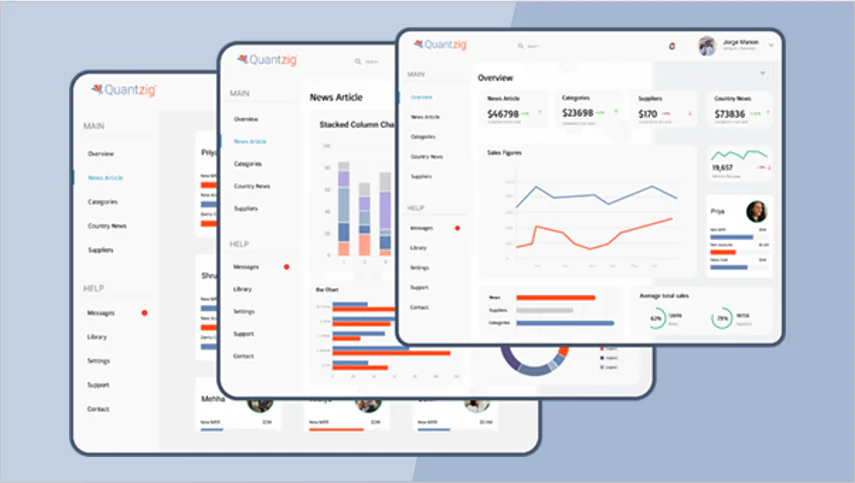In the modern business landscape, data is a critical asset driving decision-making, innovation, and efficiency. As companies strive to manage and leverage their growing volumes of data, two storage solutions often come into focus: data lakes and data warehouses. While both serve as repositories for data, they differ in how they store, process, and analyze information. Understanding these differences is key to building a data strategy that aligns with your organization’s needs and goals.
In this blog, we’ll explore the key distinctions between data lakes and data warehouses, from their architecture to the types of data they store. By examining these differences, businesses can make more informed choices about which solution best fits their data management requirements, helping them unlock deeper insights, improve operational efficiency, and drive long-term success.
Explore how our data management solutions can optimize your analytics strategy.
Request a DemoTable of Contents
What is a Data Lake?
Data Lake: A data lake is a centralized repository designed to store vast amounts of raw, unstructured, and structured data at any scale. Unlike traditional storage systems, data lakes can hold data in its native format, whether it’s text, images, videos, log files, or sensor data. This makes data lakes ideal for handling large volumes of diverse data types, which can be processed and analyzed later as needed. Businesses use data lakes to store everything from customer interactions to social media feeds, enabling data scientists and analysts to access and process it for advanced analytics, machine learning, and big data applications.
Key Benefits of Augmented Reality Technology for Business
- Scalability: Data lakes are highly scalable, capable of handling massive amounts of data. They can store data from a variety of sources, including structured, unstructured, and semi-structured data, making them ideal for big data applications.
- Flexibility in Data Types: Data lakes support various data formats such as text, images, videos, and log files. This flexibility allows organizations to store raw data in its native form without requiring upfront structuring.
- Real-time Data Processing: Data lakes support real-time data ingestion and processing, enabling businesses to capture and analyze data as it is generated. This is crucial for applications like IoT, where data arrives continuously.
- Cost-Effectiveness: Storing raw data in a data lake is generally more affordable than in traditional databases. This makes it a cost-effective solution for companies looking to store large datasets without heavy upfront investment.
- Advanced Analytics Capabilities: Data lakes provide a platform for advanced analytics, including machine learning, predictive analytics, and big data processing. Analysts and data scientists can explore complex datasets and extract meaningful insights.
Use Cases of Data Lakes
- AI and Machine Learning: Organizations can train ML models on raw data stored in lakes without needing to structure it first.
- IoT and Sensor Data Storage: Companies dealing with IoT devices store continuous sensor data for analytics.
- Real-Time Big Data Processing: Data lakes handle streaming data from various sources, making them ideal for real-time analytics.
- Customer Behavior Analysis: Marketers analyze large-scale user behavior data to improve customer segmentation and personalization.
- Healthcare Research: Genomic data, patient records, and medical imaging are stored for advanced research and analytics.
What is a Data Warehouse?
Data Warehouse: In contrast, a data warehouse is a more structured storage solution optimized for analytical processing. It stores clean, processed data that is typically sourced from multiple systems within an organization. Data in a warehouse is organized into schemas, making it easier for analysts to query and generate insights. Unlike data lakes, data warehouses primarily handle structured data, often gathered from transactional systems, and are used for business intelligence (BI) activities, such as generating reports, dashboards, and data visualizations. Data warehouses are built to provide fast and efficient querying capabilities, supporting decision-making processes across various business functions.
Key Features of Data Warehouses
-
Data Integration
Consolidates data from multiple sources for comprehensive analysis.
-
Security & Compliance
Features robust data governance, security, and regulatory compliance.
-
Structured Data Management
Organizes data in a predefined format for efficient querying.
-
Optimized for Analytics
Designed for fast data retrieval, making it ideal for business intelligence tools.
-
SQL & BI Tools Compatibility
Allows non-technical users to query data using SQL-based tools.
Use Cases of Data Warehouses
- Financial Reporting: Banks and financial institutions use warehouses for transaction tracking and compliance reporting.
- Retail Sales Analytics: Businesses analyze sales trends, customer behavior, and inventory management.
- Supply Chain Optimization: Companies use warehouses to track supply chain efficiency and improve logistics.
- Healthcare Compliance: Hospitals store patient and billing data for regulatory compliance.
- Marketing Performance Analytics: Companies evaluate marketing campaign performance using structured data.
Data Lake vs Data Warehouse: Key Differences
| Feature | Data Lake | Data Warehouse |
|---|---|---|
| Data Type | Structured, Semi-structured, Unstructured | Structured |
| Processing | Schema-on-Read | Schema-on-Write |
| Use Case | Machine Learning, Big Data, IoT | Business Intelligence, Reporting |
| Storage Cost | Low (cloud-based) | Higher (optimized for performance) |
| Query Speed | Slower | Fast |
| Security | Less regulated | Highly regulated & compliant |
| Best For | Data scientists, analysts, AI developers | Business analysts, executives |
Importance of Choosing the Right Storage Solution
Selecting between data lakes and data warehouses impacts data accessibility, scalability, analytics capabilities, and cost-effectiveness. Businesses must evaluate their data strategy based on analytical needs, budget, and regulatory requirements.
Advantages of Data Warehouses
- Structured Query Performance – Optimized for fast and complex queries with high indexing and partitioning capabilities.
- Enhanced Security – Implements strict access controls, encryption, and data governance policies to ensure compliance.
- Reliable Data Integration – Merges data from multiple sources for comprehensive and consistent reporting.
- High Data Quality – Ensures clean, structured, and validated data, reducing errors in decision-making.
- Ideal for Business Users – Non-technical users can access insights via BI dashboards with interactive visualizations.
Disadvantages of Data Warehouses
- Expensive – Higher costs due to complex infrastructure, licensing, and maintenance requirements.
- Less Flexibility – Limited to structured data, making it less suitable for AI-driven analytics that require unstructured data.
- Complex ETL – Requires extensive Extract, Transform, Load (ETL) processes, leading to longer setup times.
- Scalability Challenges – Expanding storage and processing capabilities is costly and time-consuming.
- Delayed Insights – Data must be processed and structured before analysis, increasing latency for real-time analytics.
Experience the advantages firsthand by testing a customized complimentary pilot designed to address your specific requirements. Pilot studies are non-committal in nature.
Request a PilotStrategies for Integrating Data Lakes and Data Warehouses
Hybrid Data Architecture
By using a hybrid data architecture, businesses can leverage the strengths of both data lakes and data warehouses. Data lakes store raw, unstructured data, while data warehouses house structured, processed data, enabling a seamless transition from raw data to valuable insights.
Data Virtualization
Data virtualization creates a unified, real-time view of data from both data lakes and data warehouses. This allows businesses to access and analyze data without physically moving it, providing flexibility and efficiency across diverse data environments and systems.
Automated ETL Pipelines
Cloud-native ETL (Extract, Transform, Load) tools automate data processing between lakes and warehouses. These pipelines streamline data flow, reduce manual intervention, ensure timely data availability, and enable businesses to maintain high-quality, actionable insights across both storage solutions.
Metadata Management
Establishing metadata management frameworks is essential for maintaining data consistency, traceability, and accessibility. Proper metadata management ensures that both structured and unstructured data are well-documented, enabling seamless integration and compliance across the entire data ecosystem.
Cloud-Native Solutions
Adopting cloud-native platforms like AWS, Azure, and Google Cloud provides scalability and cost-efficiency for data management. These platforms offer powerful tools for both data lakes and warehouses, allowing businesses to store, process, and analyze large datasets on-demand with minimal infrastructure overhead.
Applications in Modern Business
In modern business, the integration of data lakes and data warehouses provides organizations with powerful tools to unlock valuable insights from vast and diverse datasets. Data lakes enable businesses to store large volumes of unstructured data, such as social media feeds, customer interactions, and sensor data, which can be analyzed for trends, sentiment, and predictive insights. Meanwhile, data warehouses support structured data, making it easier to generate reports, dashboards, and business intelligence to guide strategic decisions. Together, they form a comprehensive data strategy that addresses various business needs.
These integrated data storage solutions are particularly valuable in industries like finance, healthcare, retail, and manufacturing, where data-driven decision-making is critical for success. Data lakes can support real-time analytics for monitoring operations, while data warehouses enable historical trend analysis for forecasting. By utilizing both, businesses can enhance customer experience, improve operational efficiency, and drive innovation, ultimately gaining a competitive edge in the marketplace.
Some of the applications are as follows:
Finance: Data warehouses power risk analytics and fraud detection, while lakes store historical financial data.
Healthcare: Data lakes enable genomic research and predictive analytics, whereas warehouses support compliance reporting.
Retail & E-commerce: Warehouses manage customer insights and demand forecasting, while lakes handle real-time behavioral data.
Manufacturing: Data lakes store IoT sensor data, and warehouses provide operational efficiency analytics.
Marketing: Warehouses enable customer segmentation, while lakes facilitate AI-driven personalization.
What the Future Holds
The evolution of data management is shifting towards data lakehouses, a hybrid solution combining the best features of both storage models. This approach offers structured querying, real-time analytics, and AI-driven insights.
Advancements in data integration, automation, and AI-powered analytics will further enhance data lakes and warehouses, ensuring better scalability, security, and business intelligence capabilities in the future. As businesses generate more data, selecting the right architecture will remain crucial for driving innovation and competitive advantage




